LEDs are low-voltage light sources that need either a constant DC voltage or current to operate correctly. Operating on DC power has advantages as it enables LEDs to easily work with many different power supplies/batteries, it permits longer stand-by power, and increases safety. A single high power LED like the emitters we offer on 20mm star boards require about 2-4VDC and at least 350mA of current.
If you’re using a battery, you don’t have much to worry about as batteries give off DC power. For a constant voltage LED you could simply hook the battery to the LED and for LEDs needing constant current you could just put a low voltage constant current driver in between the battery and the diodes. It is when you start setting up larger systems running from line voltage, typically between 110 and 120VAC, that you will need more components to bring down the AC voltage to DC and protect the LEDs from line-voltage fluctuation.
With smaller systems, like desk lamps and such, it will probably be easier to still stick with a low  voltage driver. In this case you will need a constant voltage power supply, like one that powers a laptop, to plug into the wall and then deliver a safe low DC power to the constant current driver that will then deliver a steady current to your LED. These constant voltage power supplies will also be all you need if your LEDs are already regulating the current (LED Strip Lights) and you only need a constant voltage, usually 12VDC or 24VDC. This system works great for small and portable lighting systems.
voltage driver. In this case you will need a constant voltage power supply, like one that powers a laptop, to plug into the wall and then deliver a safe low DC power to the constant current driver that will then deliver a steady current to your LED. These constant voltage power supplies will also be all you need if your LEDs are already regulating the current (LED Strip Lights) and you only need a constant voltage, usually 12VDC or 24VDC. This system works great for small and portable lighting systems.
 In larger systems when you start adding more LEDs into the array, a higher voltage will be required. If you were to use the low voltage method you would need huge power supplies that then link into low voltage drivers, which could get messy with all the wiring. Thankfully there are constant current drivers that take AC power directly and then give off a constant DC current with a safe voltage range for the LEDs to operate in. These are great for general lighting purposes around the home and when you retrofit a more permanent, stationary fixture.
In larger systems when you start adding more LEDs into the array, a higher voltage will be required. If you were to use the low voltage method you would need huge power supplies that then link into low voltage drivers, which could get messy with all the wiring. Thankfully there are constant current drivers that take AC power directly and then give off a constant DC current with a safe voltage range for the LEDs to operate in. These are great for general lighting purposes around the home and when you retrofit a more permanent, stationary fixture.
Today, it seems ‘LED driver’ and ‘LED power supply’ are used interchangeably. Here at LEDSupply when we say ‘power supply’ we mean an AC-DC device that takes line voltage and outputs a constant DC voltage (12V, 24V, etc.). When we say, ‘LED driver’, we mean an AC to DC driver that takes 110-305VAC and outputs a constant current to your LEDs. Other people will use names like AC LED power supply, 110V LED Driver or constant current LED power supply. It can get confusing but the names are just technicalities, what matters most is knowing what type of input your LED(s) require, and purchasing an LED power supply or driver that will provide that.
To learn more about constant current drivers and why current needs to be regulated to LEDs, see here. In the rest of this post, however, we will go over why AC LED drivers, or off-line drivers, are beneficial and how they can cut down on the size and cost of your LED system.
Line Voltage Convenience
As we have already touched on, AC drivers for LED lighting really make a difference when setting up commercial and residential systems. For battery applications and small lamps, of course it is smarter to stick with low voltage. But when you are running multiple lights off of 110V, things can get a little complicated if you only want to stick with low voltage drivers. This would require multiple switching power supplies and drivers, making the component count sky rocket, not to mention the price!
AC LED drivers eliminate the need for the added components. They switch the voltage and output a constant current to the LEDs all in one package. 110V LED drivers work much better with larger loads and carry power better over distance. Using them will also make the wiring look more professional. You will only have one to a few AC- LED drivers powering a room of lights rather than power supplies and drivers running all over the place. Cost will be lower as well as the total number of components which makes connecting under the same dimmer much more simple.
The AC Dimming Advantage
With LEDs, dimming is done in a variety of ways. Most LED drivers are compatible with 0-10V Dimming control devices that are available all over as this has become common practice for LED lighting and was even used for fluorescent dimming before LEDs were around. 0-10V dimming is a simple and very effective way of dimming multiple LED lights, but sometimes users want more.
With many users that are already in a home with smart lighting controls or a large line voltage dimming set up, it is a make or break situation on if they can make their LEDs work with this system. With low voltage LEDs and drivers this is not an option, but AC drivers continue to improve upon their use with line voltage dimmers. This includes the more popular dimming controls from the likes of Lutron and Leviton.
The new Phihong Triac Dimmable AC driver line we offer, for instance, offers quality dimming with many popular dimmers. This allows you to hook a driver right up to line voltage and then adjust the LEDs without flicker and shifting of light. Many of these dimmer systems are expensive so you can imagine how big of a deal this is for those that already have made an investment into a dimming system. Now they can switch to more efficient lighting in LEDs, while keeping the same dimmers!
Selecting the right AC (110V) LED driver
When selecting a constant current LED power supply for your system you must pay attention to a few different specs in order for the driver to work properly, and in turn, your LED system to run at its full brightness and efficiency. You need to make sure your system stays within parameters safe for both the driver and the light emitting diode itself. Below is a small list of design and technical options that you will want to go over before selecting your AC to DC driver.
1. Size
Physical size and shape are obviously a factor when choosing a 110V LED driver. Whatever fixture or light you are trying to build, you will need a driver that can fit within the application, not making it look bulky or thrown together. LED drivers come in a wide range of sizes; in small rectangle forms, longer butterstick styles, and also puck style drivers. All you need to do is pick a shape and size that works well for your setup. Whether you have room to fit the driver within your fixture, or if you plan to mount it up in the ceiling or a wall, just make sure you factor this part into your design. All measurements are on the product pages of the drivers.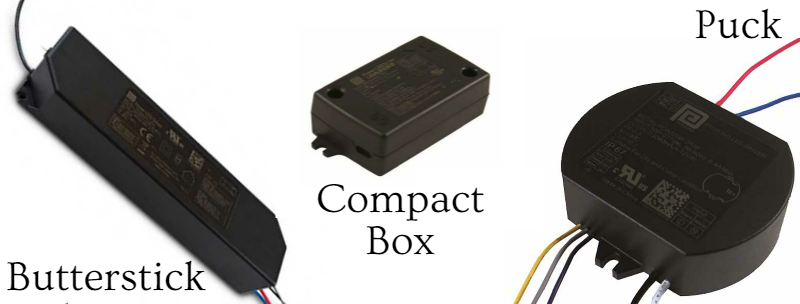
2. Current Ratings
High Power LEDs will need at least 350mA of current. There is always a maximum current rating for LEDs, and if you go over that specified current, the LED will be driven too hard and degrade at a fast rate until it ultimately fails. Make sure you know the max current your LED can take and get a constant current LED driver that outputs a current at or below that current so your LEDs will run safe and much longer. A Cree XP-E2, for example, has a max rating of 1000mA, therefore you would want to choose a driver that outputs 1000mA (1 Amp) or less. Whereas if you were using the Cree XP-L, which can be driven up to 3000mA, you would not have this problem and could use any of our drivers, including this 72W Phihong Driver that outputs 3 Amps (3000mA) and would drive them at their max which is super bright!
Important note if you are using a parallel circuit! Remember that if you have LEDs in parallel off of a driver, that drivers output is divided by however many different strings you have. So say you are running two strings of two Cree XP-E2 LEDs from the example above. Since the current is divided equally among the strings, you could use a driver that has an output as high as 2000mA.
3. Output Voltage (DC) Range
Voltage range is a very important part when working with line voltage drivers. The whole advantage of using AC LED drivers is the driver takes your 110VAC and outputs DC power. The power that is output is a constant current, but there is also an output voltage range that the LEDs must operate in. This means that your LED’s forward voltage (Vf) must be within that range (not any lower, not any higher). You can find your LEDs forward voltage by checking it on the product pages or data sheets. After you know this, add up your forward voltages of all LEDs. If you have a parallel string, add up the voltage from just one of your LED strings as each line will need to be in this range, not the total. See here if you have questions about your circuit wiring. Once you know your total voltage you will need to select a driver that has an output range including that voltage.
Say I want to set up some lights around a room in my house to highlight the wall  art. I have 5 paintings in this room that I want to illuminate with a small spot, for each, using the Cree XP-L 1-Up. I have decided that at 1000mA it will give me the brightness I need to show off these pieces. First, I find that at 1000mA the XP-L’s forward voltage (Vf) is about 2.95. I need 5 of these set up in the room so 5 x 2.95 = 14.75. So now the trick of finding a driver to take my 110 volts AC and output 1000mA while staying in a range that includes 14.75 volts. After looking in the AC driver section and using the output current filters, I find this Phihong 15W driver that outputs a current of1000mA and has an output voltage range of 10.5-15VDC.
art. I have 5 paintings in this room that I want to illuminate with a small spot, for each, using the Cree XP-L 1-Up. I have decided that at 1000mA it will give me the brightness I need to show off these pieces. First, I find that at 1000mA the XP-L’s forward voltage (Vf) is about 2.95. I need 5 of these set up in the room so 5 x 2.95 = 14.75. So now the trick of finding a driver to take my 110 volts AC and output 1000mA while staying in a range that includes 14.75 volts. After looking in the AC driver section and using the output current filters, I find this Phihong 15W driver that outputs a current of1000mA and has an output voltage range of 10.5-15VDC.
One minor drawback to offline (AC) drivers is that the output voltage ranges tend to be higher. With high power LEDs running around 2-4 volts, most AC drivers do not have low enough voltage ranges to power just one or even two LEDs. This small Phihong 6 Watt driver is actually the only AC driver that we carry that is small enough to power just one LED as its minimum output is 2.5VDC. If you need more options for powering just one LED, it is probably better to check out a low voltage option.
4. Wattage
Many people forget to even keep track of wattage when dealing with AC drivers. They just make sure that they are operating within the voltage range and don’t even care to check that they are within the Wattage limit as well. All drivers are rated for a certain wattage, in fact, most AC drivers will have this right in their name (3 Watt LED driver, 15 Watt LED driver, etc). I would advise anyone reading this post to always use this as their last checkpoint. After you have made sure current and voltage line up, you have everything you need to easily check the wattage. All you need to remember is:
System Wattage = Forward Voltage (Vf) of ALL LEDs x Drive Current (in Amps)
So let me do my final check for my art display project in the above example. I have a total forward voltage of 14.75 and am driving them at 1000mA which is equal to 1 Amp. So my wattage is 14.75 which is just under the 15 Watts that this driver can handle. Looks like I selected a driver that will work!
5. Dimming
This is all up to you! LEDs can be super bright and there obviously is a need to dim them for certain applications. When selecting your driver you should know if you want dimming or not, and then if you do, what kind of dimming you are working with. Many AC drivers have integrated 0-10V dimming, this is low voltage dimming so wires come from the driver to the dimmer in order to dim the LEDs.
A big advantage with AC drivers, especially with the new Phihong line, is line voltage dimming. This is the most common way for dimming residential lighting so I’m glad we are able to offer a Triac dimmable line that can use popular household dimmers to dim the light without a bad flicker. With this dimming type you will have your line voltage dimmers and then the driver and LEDs coming off of that.
So basically, if you just have an application where no dimming is needed, simply select a driver with no dimming as they cost less. If you need dimming, know the system you are using and look for a dimmable LED power supply that works with the dimming system you have in place.
Driver Efficiency
When a transformer is required (when you are going off AC power, not battery) DC drivers and AC drivers have very similar efficiency. AC drivers are essentially an LED power supply and LED driver combined, they take in 110v and output a DC voltage while driving the LEDs at a constant current. That being said, when sticking with low voltage drivers and going through a transformer, the system is only as good as the power supply. If the power supply is cheaper then it likely doesn’t have the highest efficiency. If you wanted to gain the same efficiency as using an AC driver, it would be best to purchase a higher end power supply like the lines from Phihong.
Cost Comparison
Going back to my example above, lets say that a friend of mine suggested using low voltage drivers rather than the offline driver I had originally selected for the spot lights around the room. Considering this option, I take a look at the prices. We already know that if I went with a 110AC LED driver I would use the 15W Phihong Triac Dimmable driver that would cost me $22.49.
If I went with a low voltage driver I would first need a power supply. A 24 volt power supply will suffice as long as it can handle 15 Watts which all our 24VDC power supplies do. The smallest is this Mean Well APV. Then you would need a small 2.1mm female connector that could hook from the power supply jack to the wires coming off your driver, this would be $1.49. Finally you would need a low voltage 1000mA driver that can handle 24VDC like the LuxDrive BuckBlock for $17.99. The total cost for the low voltage route is $41.47, an 84% increase in price.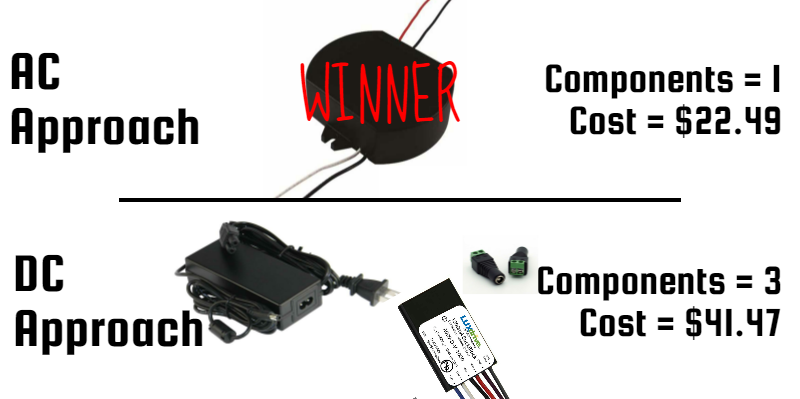
You can see that in general lighting situations like these it will be cheaper to run a driver from 110-240VAC. Now cheaper is not always better, but in this situation, that is the case as it also cuts down on the number of components, making for a more professional looking light. Not only this but with the AC option I can also dim through line voltage dimmers. I don’t have to purchase a different dimmer! I highly recommend AC drivers in cases like these along with LED retrofits. If you want to dim from line voltage with popular Lutron dimmers then Phihong’s TRIAC dimmable line, like the one I chose for my example, is a great option!
There is no straight up right or wrong answer when choosing to use DC or AC drivers. It really depends on your setup and the needs of your application. Start by looking through the list I made above, this should really narrow down your choices.

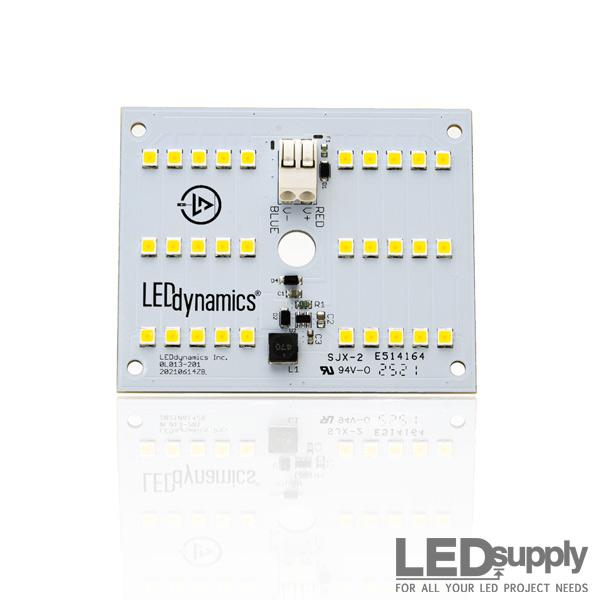
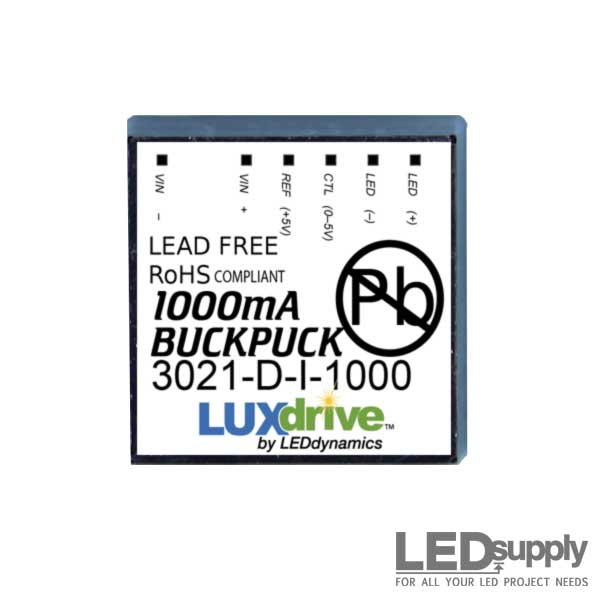

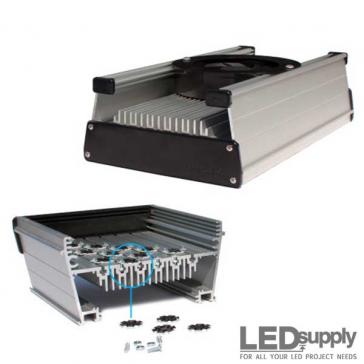
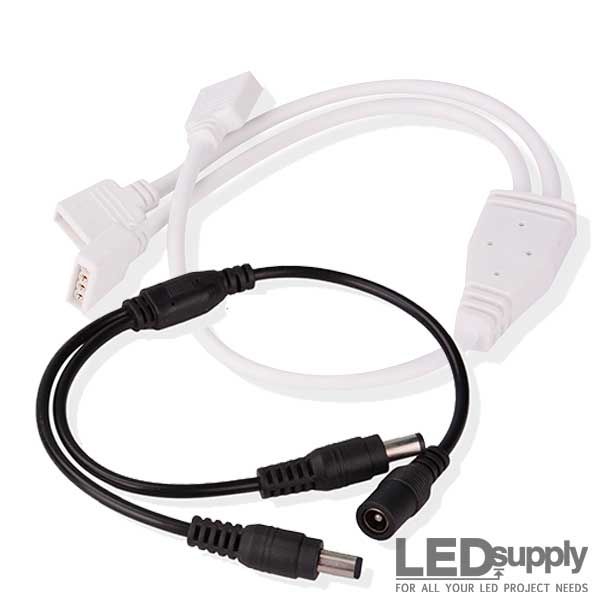
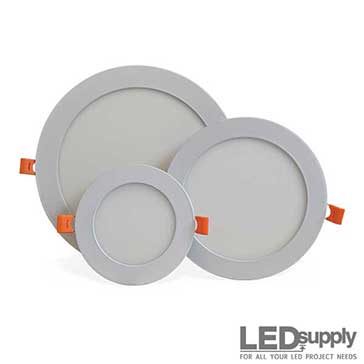
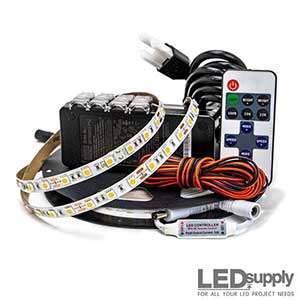









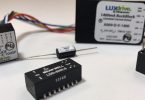























[…] Running from AC? See how an AC driver will benefit you! […]